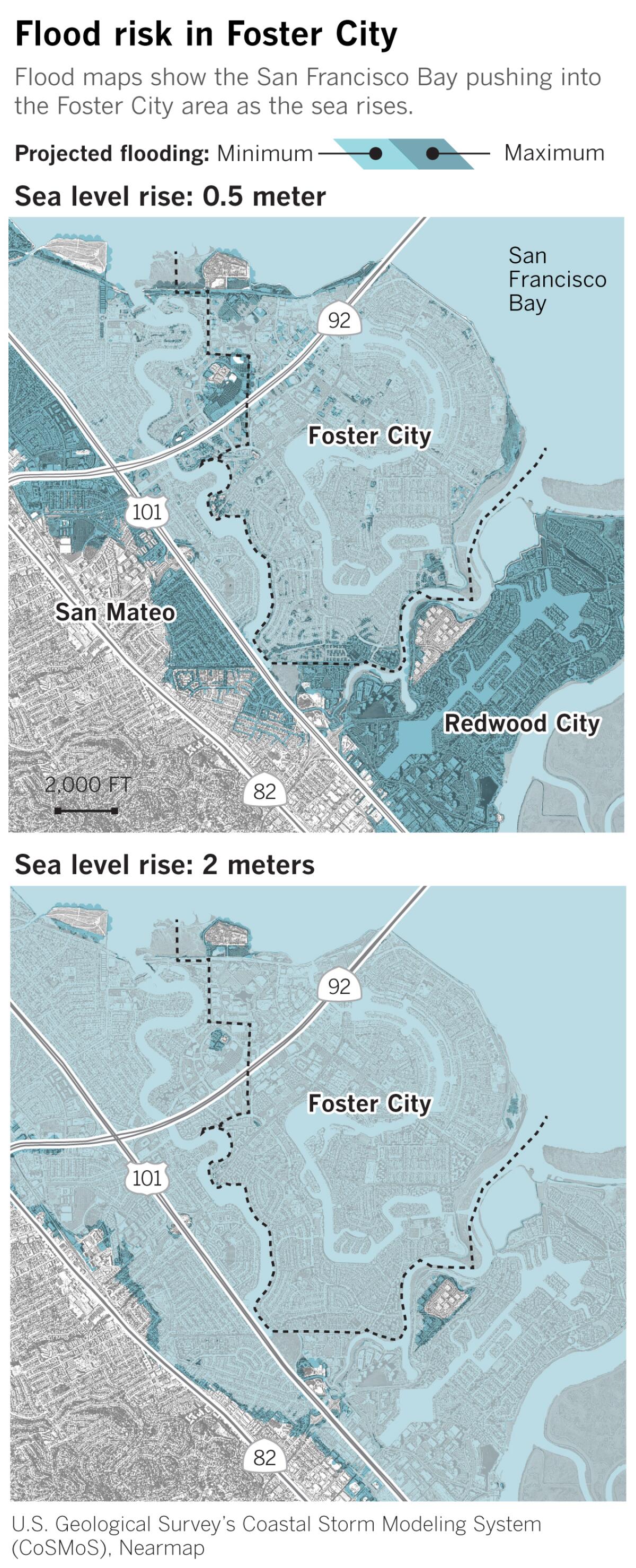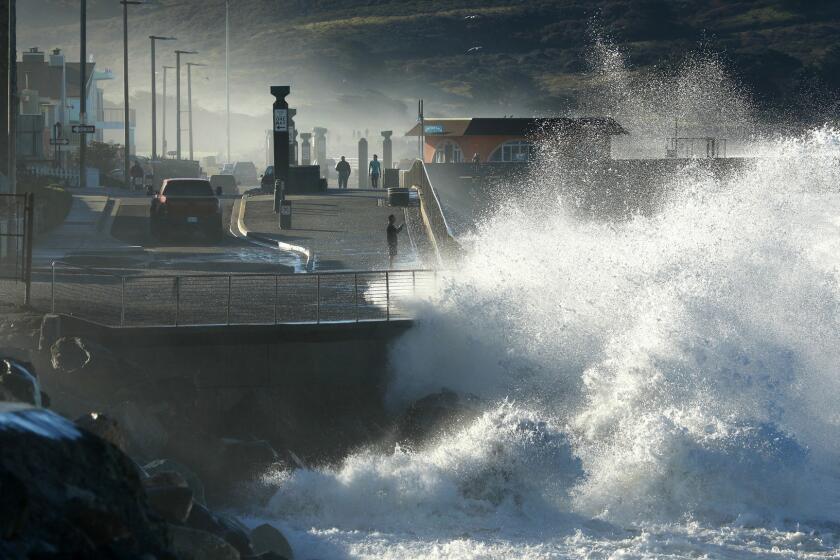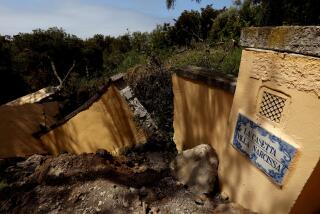Rising seas already overwhelm the Bay Area. Time is running out for California to act
- Share via
FOSTER CITY, Calif. — When Jeff Moneda first started working for Foster City, where trails wind along the town’s scenic lagoons and the nicest homes perch along its picturesque canals, he received an email from federal emergency officials that jolted him into action.
“The first thing in my inbox was a letter from FEMA that said, ‘You need to raise your levee or we’re going to place the entire city in a flood zone,’” said Moneda, the city manager. “Talk about stress.”
For a city of 34,000 that was built on filled-in marshland along San Francisco Bay, the future hinges on the strength of an eight-mile-long levee that for decades has held back the rising sea. But with every tide and storm, the water keeps trying to move back and reclaim the town. Flood maps, even in more moderate scenarios, show much of the city inundated if nothing is done.
The fate of Foster City and the rest of the Bay Area was front and center last week as state lawmakers grappled with the many threats California must confront as the ocean pushes farther inland. A special committee of state lawmakers gathered — for the second time in two months after years without meeting — to reignite a much-needed discussion on how to better prepare communities up and down the coast from devastating loss.

Homes are flooding and critical roads and infrastructure are already mere feet from toppling into the sea, they said, but cities up and down the coast have been paralyzed by the difficult choices ahead. More than $150 billion in property could be at risk of flooding by 2100 — the economic damage far more destructive than from the state’s worst earthquakes and wildfires.
Failure to act will result in lost opportunities to be proactive — and much higher costs, according to scientists, local officials and legislative analysts who spoke before the state Assembly’s Select Committee on Sea Level Rise and the California Economy.
Assemblywoman Tasha Boerner Horvath (D-Encinitas), who revived the committee last year, acknowledged just how much is at stake and said the Legislature needs to act fast and figure out what to prioritize.
“We are already 10 years late to this issue,” she said, “and there are options that are slipping away from us as we postpone a very difficult conversation.”
These remarks come at a time when more officials across the state are waking up to the social, economic and environmental catastrophe of sea level rise. The Ocean Protection Council, an advisory body tasked with guiding the state’s coastal policies, is now pushing California to be prepared for at least 3.5 feet of sea level rise by 2050.
Legislative analysts, in an unprecedented report, recently made the case that any action — or lack of action — within the next 10 years could determine the fate of the California coast.
For those in the Bay Area — where millions of people rely on major roads and infrastructure at risk of chronic flooding — fighting against the sea has been a costly and overwhelming challenge.
With just 2 feet of flooding around the Bay Area, as many as 90,000 people could be left homeless, one official said. Keeping the island city of Alameda above water could cost almost $1 billion, another said, but would avert $8 billion in damage. Infrastructure engineers made the case for better sea walls to protect the San Francisco and Oakland airports — both built on bay fill and barely supported by aging dikes.
In Foster City, property owners ended up agreeing — by a more than 80% vote — to tax themselves $90 million to raise the levee many feet higher. Officials hope to start construction as early as this summer.
The barrier, mostly earthen, currently curves along the bay for miles. On Saturday, the morning of the annual king tide — a period when the sun, moon and Earth are aligned closest together and create a higher-than-high tide — water levels rose as high as 9 feet, according to the nearest tide gauge.
Across the bay, groups of people gathered on piers and harbors, beaches and estuaries, to witness the water creeping up bridges and pushing into wetlands and low-lying roads. These extreme tides, coastal scientists say, will eventually become the new normal.
Compounding the problem in this region is groundwater flooding as the ocean moves farther inland — what some researchers call “the sea beneath us.”
As the ocean rises, that pressure pushes freshwater up from beneath our feet, said Kristina Hill, whose research at UC Berkeley focuses on this less-talked-about sea level rise issue. Basements and underground foundations will heave, brackish water could corrode sewer pipes, toxic contaminants buried in the soil could bubble up and spread.
“We could spend hundreds of billions of dollars and still have flooding on the inland side of all those levees,” Hill told the sea level rise committee, showing a map of areas where the water is already leaking out of the ground. “We’re very concerned about human health and the health of the bay.”
Solutions, experts say, depend on more cities, transportation officials and property owners working together across regions. Too many are still jostling for money and approvals to defend what’s theirs — rather than seeing the much bigger picture.
Rising tides and former marshes do not heed to city boundaries or property lines, they said, and the action of one jurisdiction may affect another down the coast. There needs to be more coordination, officials agreed, to restore wetlands and rethink critical infrastructure that serves more than any one community.
San Mateo County, for example, recently formed a cross-jurisdictional sea level rise resiliency district that is funded even by its inland communities. Officials say this new flood control approach allows the region to plan for all its shoreline needs in a way that cannot be done on a city-by-city basis.
Still, some last week worried that these new regional efforts could hurt their communities at the cost of protecting those with more political sway and power. Will the city of Millbrae, one official asked, be paying to protect more influential cities — while absorbing much of the environmental impact?
Mark Stechbart, a resident of Pacifica, called on state lawmakers to not give up on sea walls. In his town, where bluffs are crumbling and waves often overtop roads, a push by some officials to consider relocating inland has angered many property owners.
Pacifica, he said, should be “afforded the same protections as SFO and Google headquarters, which we desperately need; otherwise, very serious amounts of property value are going to go in the water.”
Warner Chabot, who heads the San Francisco Estuary Institute, said more pilot projects will help make the case for sharing resources and ideas across boundaries. He has spent years encouraging the Bay Area’s many different agencies to think about the shoreline beyond parcel by parcel, town by town.
With more support from the state, he urged lawmakers, California’s coastal communities can be “a national model of how urban regions, at the edge of the sea, can provide bold, equitable and inclusive solutions to climate change.”
More to Read
Sign up for Essential California
The most important California stories and recommendations in your inbox every morning.
You may occasionally receive promotional content from the Los Angeles Times.













